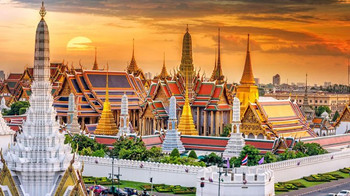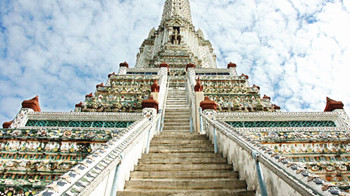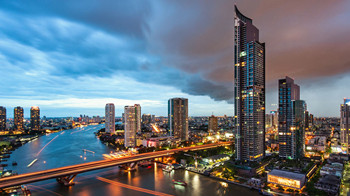Bangkok is the capital and most populous city of
Thailand. It is known in Thai as Krung Thep Maha Nakhon or simply Krung
Thep. The city occupies 1,568.7 square kilometres (605.7 sq mi) in the
Chao Phraya River delta in central Thailand, and has a population of
over eight million, or 12.6 percent of the country's population. Over
fourteen million people (22.2 percent) lived within the surrounding
Bangkok Metropolitan Region at the 2010 census, making Bangkok the
nation's primate city, significantly dwarfing Thailand's other urban
centres in both size and importance to the national economy.
Bangkok traces its roots to a small trading post during the Ayutthaya
Kingdom in the 15th century, which eventually grew and became the site
of two capital cities: Thonburi in 1768 and Rattanakosin in 1782.
Bangkok was at the heart of the modernization of Siam, later renamed
Thailand, during the late-19th century, as the country faced pressures
from the West. The city was at the centre of Thailand's political
struggles throughout the 20th century, as the country abolished absolute
monarchy, adopted constitutional rule, and underwent numerous coups and
several uprisings. The city grew rapidly during the 1960s through the
1980s and now exerts a significant impact on Thailand's politics,
economy, education, media and modern society.
The Asian investment boom in the 1980s and 1990s led many multinational
corporations to locate their regional headquarters in Bangkok. The city
is now a regional force in finance and business. It is an international
hub for transport and health care, and has emerged as a centre for the
arts, fashion, and entertainment. The city is known for its street life
and cultural landmarks. The Grand Palace and Buddhist temples including
Wat Arun and Wat Pho stand in contrast with other tourist attractions
such as the nightlife scenes of Khaosan Road and Patpong. Bangkok is
among the world's top tourist destinations, and has been named the
world's most visited city consistently in several international
rankings.
Bangkok's rapid growth coupled with little urban planning has resulted
in a haphazard cityscape and inadequate infrastructure. An inadequate
road network, despite an extensive expressway network, together with
substantial private car usage, have led to chronic and crippling traffic
congestion, which caused severe air pollution in the 1990s. The city has
since turned to public transport in an attempt to solve the problem.
Five rapid transit lines are now in operation, with more systems under
construction or planned by the national government and the Bangkok
Metropolitan Administration.


